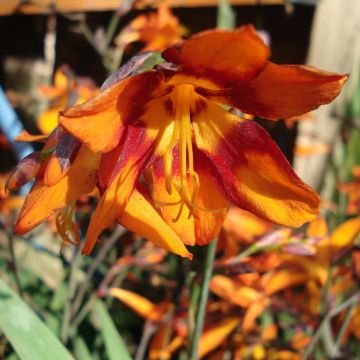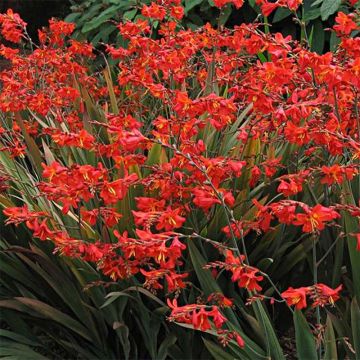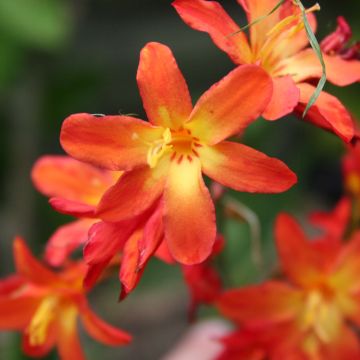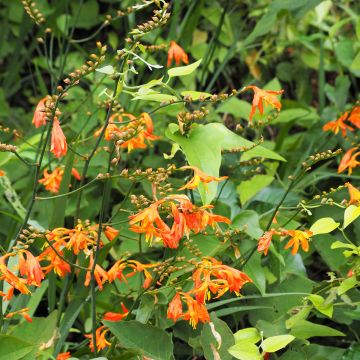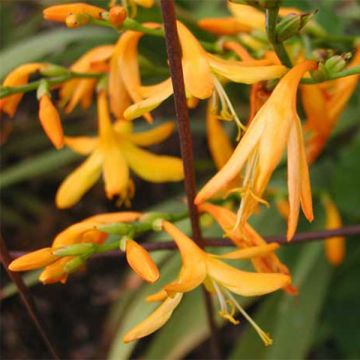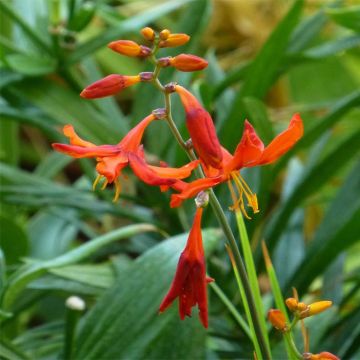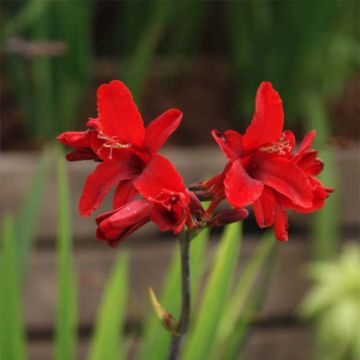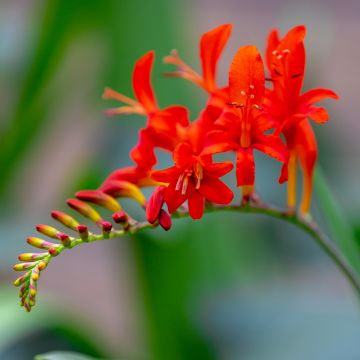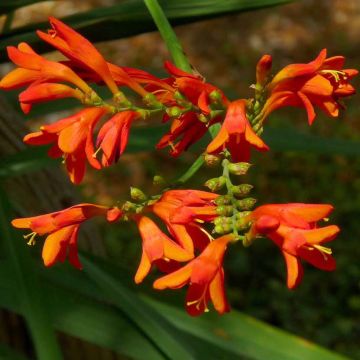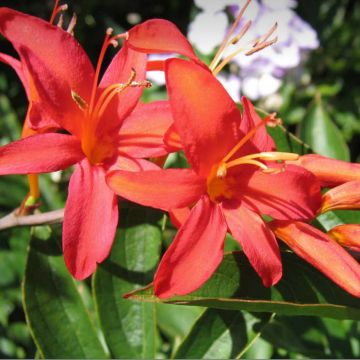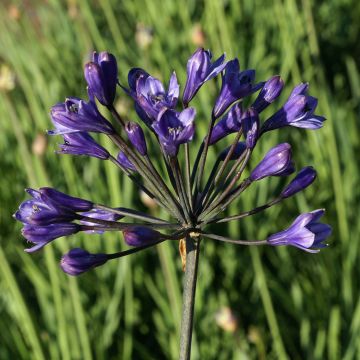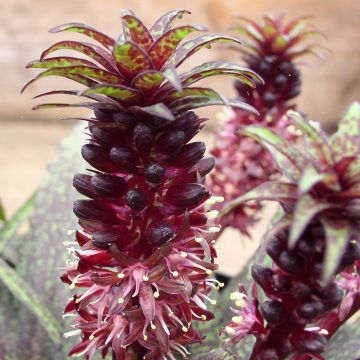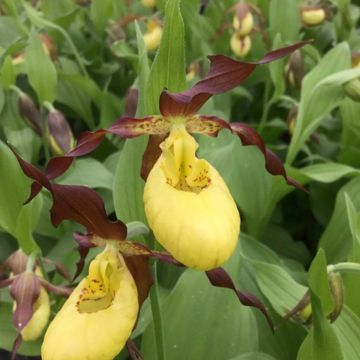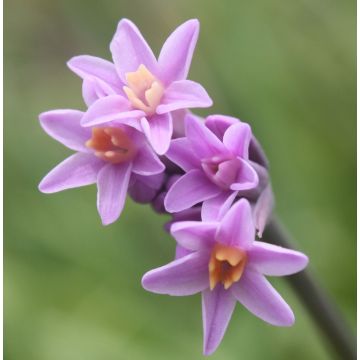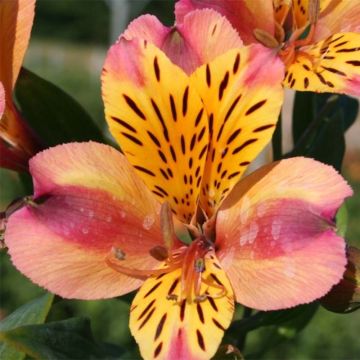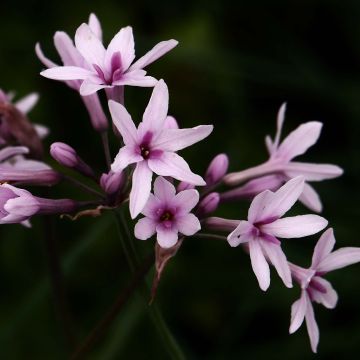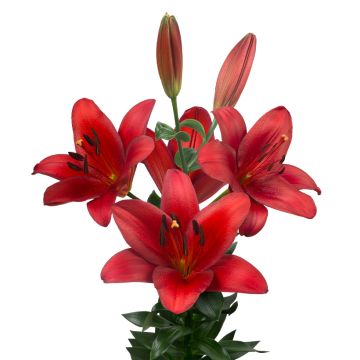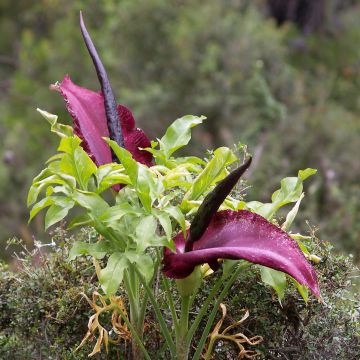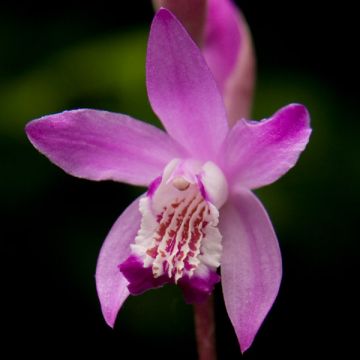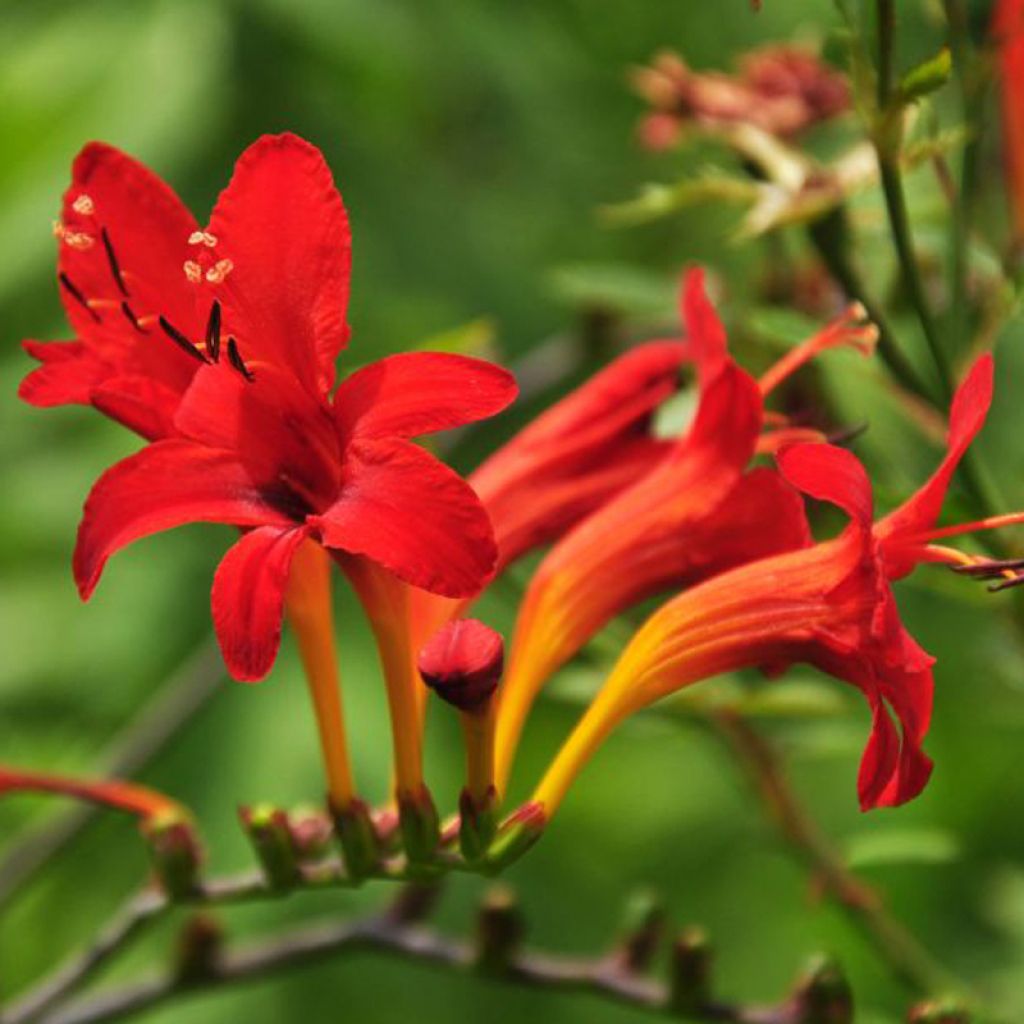

Crocosmia masoniorum - Montbretia
Crocosmia masoniorum - Montbretia
Crocosmia masoniorum
Giant montbretia
This item cannot be shipped to the selected country
Delivery charge from €5.90
More information
Schedule delivery date,
and select date in basket
This plant carries a 6 months recovery warranty
More information
We guarantee the quality of our plants for a full growing cycle, and will replace at our expense any plant that fails to recover under normal climatic and planting conditions.
From €5.90 for pickup delivery and €6.90 for home delivery
Express home delivery from €8.90.

Does this plant fit my garden?
Set up your Plantfit profile →
Description
Crocosmia masoniorum is undoubtedly the most beautiful botanical species of montbretia. It is also one of the hardiest and least water demanding. Its summer flowering consists of large mandarin-coloured flowers that stand upright, displaying an almost golden throat in the centre of a beautiful orange corolla. They open along arching spikes, rising from thick clumps composed of smooth and tapered green leaves. This remarkably floriferous and spectacular montbretia deserves to be more widely cultivated. It has produced numerous excellent cultivars (such as 'Lucifer'), to the point that it has almost been forgotten.
Crocosmia masoniorum is native to mountainous areas north of Encobo and Umtata Eastern Cape, South Africa. Becoming rare in its original region, it grows in shaded areas on moist rocky slopes, at the source of mountain streams. Its natural habitat is subject to a cold temperate climate, with abundant summer rainfall and a cold, dry winter. In cultivation, it is reportedly cold-hardy down to -25°C (-13°F), in well-drained dry soil. It is an herbaceous bulbous plant that slowly forms clumps up to 80cm (32in) tall when in flower, and at least 50cm (20in) wide. Its deciduous leaves are rigid, lance-shaped, and longitudinally plicate. They measure approximately 2.5 to 5cm (1 to 2in) wide. The flower stem emerges in July-August, bending under the weight of the flowers arranged curiously in a "fishbone" fashion in 2 ranks. They face upwards, so that the dense inflorescence forms a beautifully arched, brightly coloured display. The vivid orange flowers are tinged with red and pink. They are funnel-shaped with 6 spreading tepals. They measure up to 5cm (2in) long and 3.5cm (1in) wide.
Their vibrant colours in yellow, orange, or red create cheerful splashes in gardens. They are splendid when combined with annuals or bushes, and blend well in natural gardens with perennials, silver foliage, or grasses. They thrive in the ground in sunny exposures and well-drained soil, and will multiply over time to become more beautiful every year. They are also excellent flowers for bouquets. The masoniorum species is particularly ornamental. It will thrive in any well-drained soil, whether it is gravelly or sandy, rich or poor, moist or occasionally dry. It cannot tolerate stagnant moisture in winter.
Report an error about the product description
Crocosmia masoniorum - Montbretia in pictures
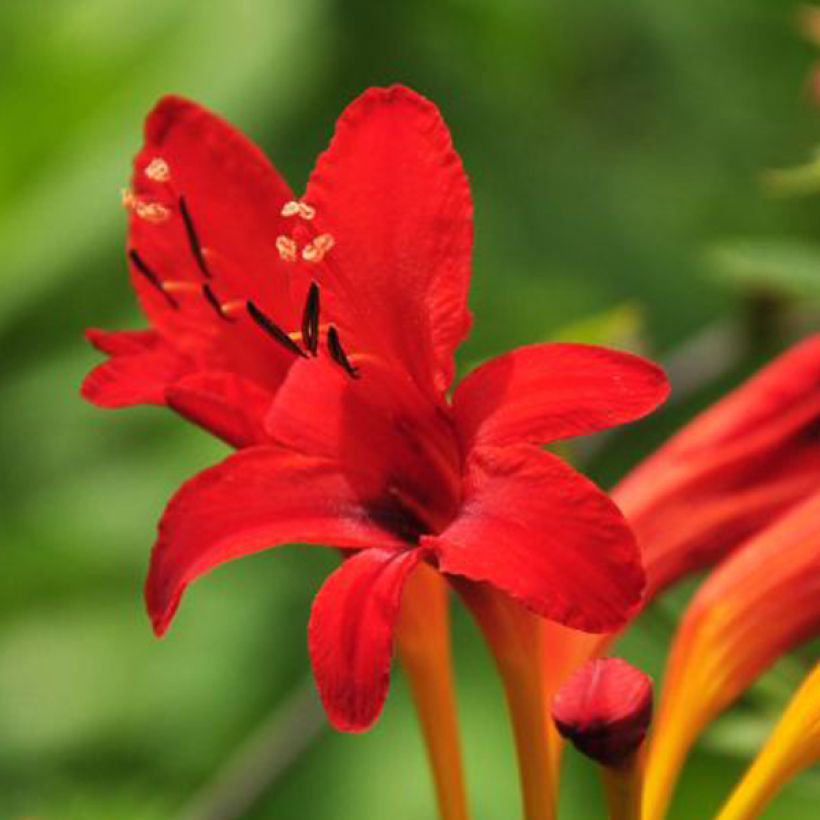

Plant habit
Flowering
Foliage
Botanical data
Crocosmia
masoniorum
Iridaceae
Giant montbretia
South Africa
Other Crocosmia
Planting and care
Plant crocosmias in full sun, ideally in spring. They need well-drained and aerated soil. Work the soil well at the time of planting and, if necessary, incorporate sand. They must be covered with 15cm (6in) of soil and spaced about 15cm (6in) apart. They like rich, loamy soils. Apply fertiliser at the time of planting and renew it every spring. While they prefer well-drained soil in winter, crocosmias need plenty of water during their growing season and cannot tolerate any drought in summer. In regions with harsh winters, it is wise to dig up the corms once the foliage has withered and store them in a frost-free location. Another alternative is to cover the bed with a thick insulating layer at the onset of winter and remove it in March.
Planting period
Intended location
Care
-
, onOrder confirmed
Reply from on Promesse de fleurs
Hardy summer bulbs
Haven't found what you were looking for?
Hardiness is the lowest winter temperature a plant can endure without suffering serious damage or even dying. However, hardiness is affected by location (a sheltered area, such as a patio), protection (winter cover) and soil type (hardiness is improved by well-drained soil).

Photo Sharing Terms & Conditions
In order to encourage gardeners to interact and share their experiences, Promesse de fleurs offers various media enabling content to be uploaded onto its Site - in particular via the ‘Photo sharing’ module.
The User agrees to refrain from:
- Posting any content that is illegal, prejudicial, insulting, racist, inciteful to hatred, revisionist, contrary to public decency, that infringes on privacy or on the privacy rights of third parties, in particular the publicity rights of persons and goods, intellectual property rights, or the right to privacy.
- Submitting content on behalf of a third party;
- Impersonate the identity of a third party and/or publish any personal information about a third party;
In general, the User undertakes to refrain from any unethical behaviour.
All Content (in particular text, comments, files, images, photos, videos, creative works, etc.), which may be subject to property or intellectual property rights, image or other private rights, shall remain the property of the User, subject to the limited rights granted by the terms of the licence granted by Promesse de fleurs as stated below. Users are at liberty to publish or not to publish such Content on the Site, notably via the ‘Photo Sharing’ facility, and accept that this Content shall be made public and freely accessible, notably on the Internet.
Users further acknowledge, undertake to have ,and guarantee that they hold all necessary rights and permissions to publish such material on the Site, in particular with regard to the legislation in force pertaining to any privacy, property, intellectual property, image, or contractual rights, or rights of any other nature. By publishing such Content on the Site, Users acknowledge accepting full liability as publishers of the Content within the meaning of the law, and grant Promesse de fleurs, free of charge, an inclusive, worldwide licence for the said Content for the entire duration of its publication, including all reproduction, representation, up/downloading, displaying, performing, transmission, and storage rights.
Users also grant permission for their name to be linked to the Content and accept that this link may not always be made available.
By engaging in posting material, Users consent to their Content becoming automatically accessible on the Internet, in particular on other sites and/or blogs and/or web pages of the Promesse de fleurs site, including in particular social pages and the Promesse de fleurs catalogue.
Users may secure the removal of entrusted content free of charge by issuing a simple request via our contact form.
The flowering period indicated on our website applies to countries and regions located in USDA zone 8 (France, the United Kingdom, Ireland, the Netherlands, etc.)
It will vary according to where you live:
- In zones 9 to 10 (Italy, Spain, Greece, etc.), flowering will occur about 2 to 4 weeks earlier.
- In zones 6 to 7 (Germany, Poland, Slovenia, and lower mountainous regions), flowering will be delayed by 2 to 3 weeks.
- In zone 5 (Central Europe, Scandinavia), blooming will be delayed by 3 to 5 weeks.
In temperate climates, pruning of spring-flowering shrubs (forsythia, spireas, etc.) should be done just after flowering.
Pruning of summer-flowering shrubs (Indian Lilac, Perovskia, etc.) can be done in winter or spring.
In cold regions as well as with frost-sensitive plants, avoid pruning too early when severe frosts may still occur.
The planting period indicated on our website applies to countries and regions located in USDA zone 8 (France, United Kingdom, Ireland, Netherlands).
It will vary according to where you live:
- In Mediterranean zones (Marseille, Madrid, Milan, etc.), autumn and winter are the best planting periods.
- In continental zones (Strasbourg, Munich, Vienna, etc.), delay planting by 2 to 3 weeks in spring and bring it forward by 2 to 4 weeks in autumn.
- In mountainous regions (the Alps, Pyrenees, Carpathians, etc.), it is best to plant in late spring (May-June) or late summer (August-September).
The harvesting period indicated on our website applies to countries and regions in USDA zone 8 (France, England, Ireland, the Netherlands).
In colder areas (Scandinavia, Poland, Austria...) fruit and vegetable harvests are likely to be delayed by 3-4 weeks.
In warmer areas (Italy, Spain, Greece, etc.), harvesting will probably take place earlier, depending on weather conditions.
The sowing periods indicated on our website apply to countries and regions within USDA Zone 8 (France, UK, Ireland, Netherlands).
In colder areas (Scandinavia, Poland, Austria...), delay any outdoor sowing by 3-4 weeks, or sow under glass.
In warmer climes (Italy, Spain, Greece, etc.), bring outdoor sowing forward by a few weeks.

































